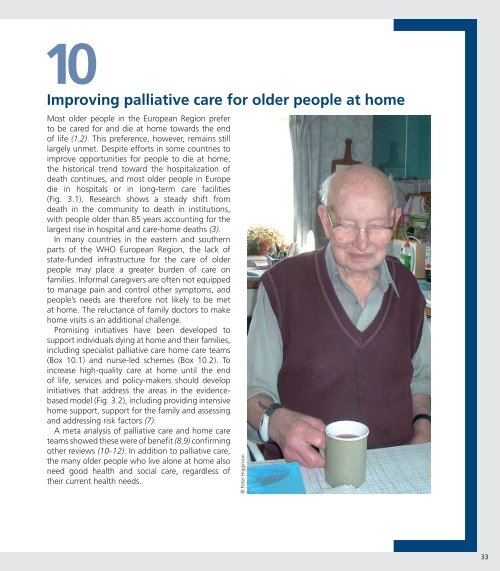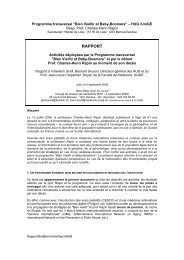Palliative care for older people - World Health Organization ...
Palliative care for older people - World Health Organization ...
Palliative care for older people - World Health Organization ...
Create successful ePaper yourself
Turn your PDF publications into a flip-book with our unique Google optimized e-Paper software.
10Improving palliative <strong>care</strong> <strong>for</strong> <strong>older</strong> <strong>people</strong> at homeMost <strong>older</strong> <strong>people</strong> in the European Region preferto be <strong>care</strong>d <strong>for</strong> and die at home towards the endof life (1,2). This preference, however, remains stilllargely unmet. Despite ef<strong>for</strong>ts in some countries toimprove opportunities <strong>for</strong> <strong>people</strong> to die at home,the historical trend toward the hospitalization ofdeath continues, and most <strong>older</strong> <strong>people</strong> in Europedie in hospitals or in long-term <strong>care</strong> facilities(Fig. 3.1). Research shows a steady shift fromdeath in the community to death in institutions,with <strong>people</strong> <strong>older</strong> than 85 years accounting <strong>for</strong> thelargest rise in hospital and <strong>care</strong>-home deaths (3).In many countries in the eastern and southernparts of the WHO European Region, the lack ofstate-funded infrastructure <strong>for</strong> the <strong>care</strong> of <strong>older</strong><strong>people</strong> may place a greater burden of <strong>care</strong> onfamilies. In<strong>for</strong>mal <strong>care</strong>givers are often not equippedto manage pain and control other symptoms, and<strong>people</strong>’s needs are there<strong>for</strong>e not likely to be metat home. The reluctance of family doctors to makehome visits is an additional challenge.Promising initiatives have been developed tosupport individuals dying at home and their families,including specialist palliative <strong>care</strong> home <strong>care</strong> teams(Box 10.1) and nurse-led schemes (Box 10.2). Toincrease high-quality <strong>care</strong> at home until the endof life, services and policy-makers should developinitiatives that address the areas in the evidencebasedmodel (Fig. 3.2), including providing intensivehome support, support <strong>for</strong> the family and assessingand addressing risk factors (7).A meta analysis of palliative <strong>care</strong> and home <strong>care</strong>teams showed these were of benefit (8,9) confirmingother reviews (10–12). In addition to palliative <strong>care</strong>,the many <strong>older</strong> <strong>people</strong> who live alone at home alsoneed good health and social <strong>care</strong>, regardless oftheir current health needs.© Peter Higginson33
















